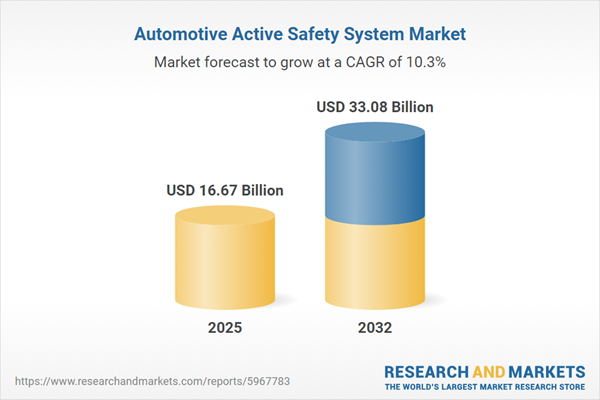Speak directly to the analyst to clarify any post sales queries you may have.
The automotive active safety system market is experiencing accelerated evolution as senior leaders prioritize next-generation safety technologies and adapt operations to new regulations. Strategic supplier partnerships and forward-focused investments are reshaping industry standards to deliver advanced, technology-driven solutions at both the vehicle and fleet levels.
Market Snapshot: Automotive Active Safety System Market
Between 2024 and 2032, the automotive active safety system market is projected to grow rapidly, outpacing traditional vehicle safety sectors. Adoption of advanced sensors, artificial intelligence, and integrated safety platforms is sharply improving detection accuracy, decision-making speed, and system responsiveness. This ongoing shift is driven by rising global compliance standards that require manufacturers and suppliers to align new developments with both hardware and software innovation. In this environment, agile product strategies are essential to address diverse regulatory landscapes and evolving customer requirements, creating opportunities to deliver differentiated solutions across segments.
Scope & Segmentation: Automotive Active Safety System Market
This analysis guides executives with precise segmentation and clarity on core market drivers, enabling strategic planning across technical, regulatory, and operational domains. Each segment reflects unique value opportunities and innovation frontiers:
- Component Type: Digital, mono, and stereo cameras, as well as LiDAR, radar, and ultrasonic sensors, enable comprehensive environmental awareness and strengthen threat identification central to system effectiveness across vehicle classes.
- Application: Adaptive cruise control, automatic emergency braking, blind-spot monitoring, lane-keeping assist, and traffic sign recognition are implemented for focused risk mitigation and compliance support across diverse operational needs.
- Vehicle Type: Solutions are configured for commercial platforms including logistics fleets and buses, as well as passenger vehicles such as sedans, SUVs, and hatchbacks, offering broad adaptability based on user requirements.
- Installation Mode: Both OEM-integrated systems and aftermarket retrofit options are available, ensuring the provision of advanced safety features for new acquisitions and the upgrade of existing fleets for greater value retention.
- Regions: Local regulations, infrastructure, and consumer preferences drive development and supplier strategies in the Americas, Europe, Middle East & Africa, and Asia-Pacific, directly impacting competitive positioning and technology rollouts in each market.
Key sector members—including Robert Bosch GmbH, Continental AG, DENSO Corporation, ZF Friedrichshafen AG, Mobileye Global Inc., Valeo SA, Magna International Inc., Aptiv PLC, Autoliv Inc., and Veoneer Inc.—focus on regulatory compliance, global technology harmonization, and streamlined deployment. These approaches reinforce supply chain resilience, enabling industry-wide innovation that adapts to varied operational contexts globally.
Key Takeaways for Senior Decision-Makers
- Integration of active safety systems is essential for aligning procurement and risk management with evolving compliance requirements and supporting ongoing fleet modernization.
- Investing in artificial intelligence, sensor fusion, and vision technology accelerates scalable automation while promoting consistent operational dependability.
- Collaboration with semiconductor and software vendors ensures uninterrupted innovation and boosts protection against supply chain disruptions.
- Customizing compliance and product strategies for specific regional and operational needs maintains stakeholder engagement and bolsters competitive differentiation.
- Retrofit solutions afford opportunities to optimize the safety and investment returns of legacy vehicle assets, promoting long-term fleet value.
- Deployment of real-time analytics and edge computing increases operational transparency, supporting informed, proactive leadership decisions and efficiency initiatives.
Tariff Impact: Navigating the U.S. 2025 Tariff Environment
Forthcoming U.S. tariffs in 2025 are introducing new challenges around sourcing and compliance for OEMs and suppliers. Strategic responses now emphasize localizing supplier networks, expanding procurement options, and boosting domestic technology integration. These measures help maintain supply chain stability, reinforce production reliability, and support manufacturing capacity during regulatory transitions.
Methodology & Data Sources: Ensuring Reliable Insights
This report merges direct interviews with major OEM leadership, expert contributions, and rigorous evaluation of regulatory filings. Benchmarking competitor movements and analysis of confirmed industry publications guarantee both accuracy and context for actionable decision-making.
Why This Report Matters for Automotive Active Safety Market Stakeholders
- Supports senior leaders in aligning investments, procurement, and operations with changing compliance and supply chain realities.
- Provides actionable insights for strategic partner selection and technology adoption, enabling dynamic responses to evolving regulatory and market conditions.
- Equips organizations with guidance on supplier collaboration and resource prioritization to optimize long-term market growth and resilience.
Conclusion
Taking a proactive stance on technology integration and robust supply chain strategies positions organizations for sustainable success in the automotive active safety system market. These insights are designed to guide strategic, timely decision-making for continued operational advancement.
Additional Product Information:
- Purchase of this report includes 1 year online access with quarterly updates.
- This report can be updated on request. Please contact our Customer Experience team using the Ask a Question widget on our website.
Table of Contents
3. Executive Summary
4. Market Overview
7. Cumulative Impact of Artificial Intelligence 2025
Companies Mentioned
The companies profiled in this Automotive Active Safety System market report include:- Robert Bosch GmbH
- Continental AG
- DENSO Corporation
- ZF Friedrichshafen AG
- Mobileye Global Inc.
- Valeo SA
- Magna International Inc.
- Aptiv PLC
- Autoliv, Inc.
- Veoneer, Inc.
Table Information
| Report Attribute | Details |
|---|---|
| No. of Pages | 190 |
| Published | October 2025 |
| Forecast Period | 2025 - 2032 |
| Estimated Market Value ( USD | $ 16.67 Billion |
| Forecasted Market Value ( USD | $ 33.08 Billion |
| Compound Annual Growth Rate | 10.3% |
| Regions Covered | Global |
| No. of Companies Mentioned | 11 |









